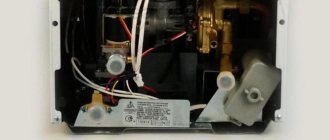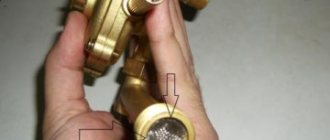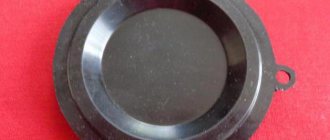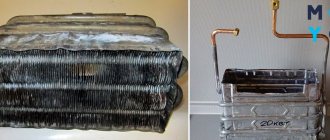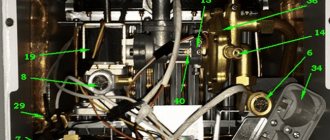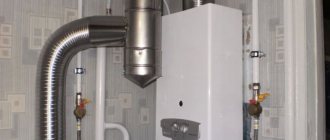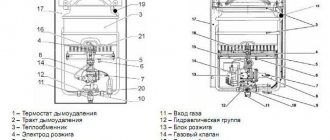Share on social media networks:
Any gas-powered water heater requires periodic cleaning and maintenance. These procedures significantly extend the service life of such devices, which is why it is recommended to carry them out at least once a year. In addition, this will facilitate the process of removing carbon deposits and scale from inside and outside the heat exchanger. Unfortunately, most users take such measures after the heater begins to fail. In this article we will tell you how to remove the heat exchanger from a gas water heater, give the main signs of contamination of the devices and tell you how to clean the units yourself.
Why is there a need to clean geysers?
Before you figure out how to clean a Neva gas water heater or any other manufacturer, you need to understand when that very moment comes and such measures should be taken urgently.
Contaminants enter the device in three types:
- Soot that is formed when gas burns. The nozzles become clogged with soot, which accumulates on the heat exchanger, thereby impairing draft and water heating.
- Contaminants present in tap water. A certain part of them settles on the filter meshes, and because of this, its throughput is significantly reduced. Impurities that have overcome the filtration barrier accumulate on the membrane, as a result of which it ceases to respond normally to changes in pressure, and the gas valve ceases to close completely.
- Scale. This is the most common problem that arises due to the crystallization of calcium and magnesium salts soluble in water, and the higher the temperature, the faster this process occurs.
Important! The heat exchanger tubes are specially made thin to ensure the fastest heating of water, so they quickly become clogged with scale.
To minimize the rate of formation of salt deposits, experts recommend following the recommendations below:
- Don't overheat the column too much. It is better for it to work in normal mode, then you will not have to dilute hot water with cold.
- In modern columns, there is no need to drill out the filter, as in home-grown devices, since it begins to generate an excessive amount of heat - because of this, the water inside the heat exchanger becomes hot when the main burner is not working.
- If the water contains a lot of magnesium and calcium salts, it is better to install a softening filter in front of the column.
The principle of operation of the draft sensor in a gas water heater
A sensor is a bimetallic relay endowed with the ability to start and turn off the boiler burner. In the inner part of the element you can find a strip made of metal that reacts to temperature changes. The manufacturer sets it to 75-900 °C (in cases where natural fuel is used) or 75-1500 °C (for liquefied gas). In situations where there is a deterioration in draft in the chimney, the degree of flue gas concentration increases, against which the temperature increases. The main function of a gas boiler pneumatic relay is to control and transmit signals about changes in temperature to the control unit. After the signal reaches the block, it enters the gas valve area. The supply of liquefied or natural gas is cut off. The sensor can also be triggered in cases where there is a disturbance in the draft in the chimney, which leads combustion products to the street.
The draft sensor of the AOGV gas boiler prevents toxic fumes from entering the house.
In boilers with closed combustion chambers, products are removed through a coaxial channel using a fan. A pneumatic relay with a membrane acts as a sensor that responds not to changes in temperature conditions, but to changes in flow speed.
When the speed is within normal limits, the membrane appears bent. Contacts are closed. As soon as the flow rate weakens, the contacts begin to open. The membrane gradually straightens. The gas supply valve is closed.
When is it time to urgently clean the gas water heater?
There are a number of signs indicating that descaling of the geyser radiator should be done as soon as possible, that is, too much dirt has accumulated in the water heater.
These include the following:
- Water flows too slowly from the hot tap, while strong pressure is observed in the cold tap.
- The column turns off immediately or does not respond to the opening of the hot valve.
- The column has stopped heating the water or the overheating sensor is constantly triggered.
- There is not enough gas supplied to the burner.
- If the chimney is working properly, the column turns off due to the activation of the draft sensor.
Main problems when using geysers Neva Lux 6011
_______________________________________________________________________________
There is a Neva Lux 6011 automatic gas water heater in the house. Can anyone tell me why it didn't start heating the water well? What do you advise me to do to solve the problem? Firstly, the heat exchanger is clogged with dirt. A high concentration of deposits on the walls of the heat exchanger prevents proper heating of the water, and the device will begin to heat the water poorly. For this reason, we advise you to clean the heat exchanger. Option two is constant overheating of the heat exchanger. This occurs due to improper use of the unit. An increase in temperature leads to the formation of scale, which slows down the heating of the liquid. In this case, it is recommended to replace the heat exchanger. I use a gas water heater of this model at my dacha. After 5 years, a leak formed from the heat exchanger. The repair did not help, and after 3 months I bought a new device. The installer said maintenance and cleaning should be done once a year. I cleaned and did preventive maintenance. As a result, this device worked for 3 years, and the reason for failure was the same - wear of the heat exchanger. Why might this happen? Most likely, the water is not of suitable quality, which causes the heat exchangers to leak. There is a model of the specified brand at the dacha. I just don’t understand why in some cases there is excessive heating of the water? What is the problem? The regulators may be set incorrectly. You should switch them for the summer. Use the gas supply adjustment knob to set the gas on the burner to minimum, and then increase the water flow on the water heater. A malfunction has appeared on the gas instantaneous water heater Neva Lux 6011. The wick lights up, I hold it in this position for about 4 minutes. After this, I switch to the operating mode, but the device goes out. Why did this happen? You need to dismantle the casing, unscrew the tube through which gas flows to the igniter, and clean it. In general, this procedure should be carried out every year, preferably at the end of summer, since the windows are open and dust will get into the gas pipe. I just don’t understand what the problem is when a gas water heater at times does not heat up satisfactorily. What should I do? Presumably, the burner has an unstable flame, which means the membrane is faulty and the rod is not pressing on the gas valve. You need to disconnect the water unit from the gas device. After this, unscrew the cap from the water unit and check the membrane for defects, and if it is worn out, replace it. Two years ago we connected a gas water heater from the specified company to heat a private house. The other day there was a problem with the ignition. When a DHW request is made, the wick is ignited. It lights up and suddenly goes out, and after this the water heater starts up again. And so two or three times. The device then functions normally. I just don’t understand why the pilot flame cannot ignite the main burner? What's happened? Now the column acts like this. A spark appears, which ignites the igniter. Then the spark discharge disappears, the wick burns for 4-5 seconds and goes out. The device resumes the spark supply, the igniter is ignited, the spark discharge stops, and after a while the main burner starts working. Apparently, there is a problem with the ionization sensor. You should inspect it first. Although, it is advisable to mount a new one, but if this does not work, we recommend cleaning this one with sandpaper. Also clean the burner using a metal brush. After these procedures, be sure to make sure that the burner flame is not yellow, but blue. In addition, the flame must reach the ionization sensor. We installed and commissioned a Neva Lux 6011 battery-powered flow-through gas water heater a year ago. But in winter, a problem regularly appears, namely, poor gas supply, and even the gas supplied is not clean. Help me solve the problem? There is an adjusting bolt at the bottom of the device. Try to turn it to the left with the burner on and set the correct amount of fire. When summer comes, turn it back. If this does not help, then the pressure in the line is really low. The geyser has been in operation for about 7 years. Not long ago, the igniter stopped working, and when you try to light it with matches, the wick may immediately go out when you move the regulator to the heating position. What can be done? I encountered the same problem. The repairmen suggested that the thermocouple needed to be replaced. Say a household geyser. When you open the hot water tap, the appliance goes out. I cleaned the thermocouple, but the result was zero. We checked the membrane, it is normal, but in any case we replaced it with a new one. There is a decrease in water pressure, but not much. How to find and fix the problem? Apparently the traction is weak or the traction sensor is broken. We advise you to check this. Occasionally, instead of a draft sensor, a curved tube is placed at the top of the water heater. With its help, air is supplied, which promotes combustion. If the draft is broken, not air, but flue gases enter the tube. Accordingly, there will not be enough oxygen for the burner, which will cause it to go out. Also check the igniter flame. It should completely cover the thermocouple. When this is not the case, the thermocouple heats up slightly and stops sending a signal to ignite the main burner. The day before yesterday the following malfunction arose: the Neva Lux 6011 flow-through gas water heater on batteries began to turn off during operation. Can anyone tell me what is the reason and how to fix it? The water unit membrane is probably faulty. It may be worn out or deformed, so it needs to be replaced. Also, this malfunction is sometimes associated with the EMC valve, since there is an electromagnetic coil inside it, which may have a malfunction. Repair of the coil is not possible, only replacement. Can anyone tell me if there is a problem with my gas water heater? 3-4 minutes after starting the device completely goes out, and subsequently the igniter can only be ignited with the help of matches. How to fix the situation? Presumably, there is no draft in the chimney, therefore the draft overturn sensor is triggered and the water heater goes out. It is necessary to check the chimney duct. Overheating of the heat exchanger may also occur when the temperature increases to 90 degrees. In this case, an overheating sensor is triggered, which will extinguish the flame. To lower the water temperature, reduce the gas supply to the main burner using the regulator. I would like to know why the gas water heater lights up and immediately goes out? What methods should be used to eliminate this breakdown? In the first case, the cause is a clogged chimney. Apparently, a fair amount of soot deposits have accumulated inside it, and combustion products are not completely removed, as a result of which the draft sensor will work. It will disconnect the thermocouple and the water heater flame will go out. The second reason is increased wind, which can blow out the flame of the column if there is a draft in the room. Accordingly, the protection mechanism will start and block the flow of gas. Strong gusts of wind should be avoided. But there is no need to completely block access to fresh air, since the device must operate with an open window. If there is no fresh air, a decrease in draft occurs and the flame will begin to go out. There is an automatic gas water heating water heater Neva Lux 6011. Could you tell me what is the reason if it began to heat the water very strongly? What should be done to solve the problem? The suspected cause is high blood pressure. Set the water heating temperature regulator to maximum flow, and set the gas regulator to minimum gas flow into the burner. This operation helps reduce the temperature of the water that comes from the water heater. For what reason is ignition delayed and the gas burner makes popping noises? The fire from the ignition mechanism does not reach the main burner, or it is insignificant. You need to clean the igniter and injector. Then perform the adjustment procedure. Gas instantaneous water heater malfunction. I'm trying to start, I can see a spark, although the pilot burner does not ignite. How to fix? The igniter nozzle is clogged with dirt. You need to rinse. The ignition electrode is in the wrong position. Adjust it. There is air in the gas line. Remove the air. We installed and connected the Neva Lux 6011 gas water heater. The problem is that the device starts to work, but then goes out after two or three seconds. Most often this happens at night, when the unit has been idle for some time. Moreover, if it heats water periodically, it does not turn off. If you switch the microswitch for a long time, the water heater lights up and continues to function perfectly for three to four days. Why is this happening? There is no need to click the microswitch, just replace it with a new one, because yours is broken. The actions of the device are approximately as follows. A spark is first formed, which goes to the igniter. An ionization signal follows, gas begins to flow to the main burner, and the flame flares up. If there is no signal that the pilot burner is working, the main burner device will not turn on either. In your case, the igniter transmits a signal although the main burner cannot start. The ignition seems to be starting, but there is no signal, which is why the gas supply is suspended. You must clean the electrode. The device is of the same brand. What can cause the igniter to go out at the moment of ignition? What kind of malfunction is this? The thermocouple has failed. Should be replaced. Coil defect. Need to replace. A question has arisen regarding the operation of the Neva Lux 11 liter automatic gas water heater. The situation is as follows: the pilot light lights up, but the main burner does not. What needs to be done and how to repair it? Insufficient water pressure. Adjust the required pressure in the system. Why do you need to turn the regulator to the extreme right position? The membrane is damaged. Make a replacement. There is a water pump at the dacha. If you turn off the water, the gas burner continues to operate. What is the cause of the problem? The valve in the gas valve becomes clogged. Check it out. Clean if necessary. The piston or hydraulic valve rod has become jammed in the open position. Remove elements, clean, replace if necessary. Check the gas inlet pressure. Adjust if necessary. Replace the gas cylinder reducer. Can anyone explain why there is no spark when the unit is turned on? The thermocouple wire has broken. Fix the wiring correctly. Igniter problem. We recommend testing this device and replacing it. The ignition electrode is damaged. Replace it.
_______________________________________________________________________________
_______________________________________________________________________________
_______________________________________________________________________________
- Gas boilers
- Electric boilers
- Gas water heaters
- Malfunctions and repairs of geysers
- Water heaters
- Boiler error codes
- Troubleshooting boilers
- Troubleshooting water heaters
- Repair of indirect heating boilers
- Troubleshooting electric convectors
_______________________________________________________________________________
- BOSCH TERM 4000
Models WR-13, WR-13. Specifications. Installation. Maintenance and adjustments.
- NEVA 4510
Design and main components. Installation and connections.
- NEVA 4511
Purpose of main components and elements. Maintenance and replacement of parts.
- NEVA 4513
Adjustments and settings. Service maintenance.
- NEVA
Design features. Malfunctions and maintenance.
- NEVA LUX 5514
Elements and components. Installation and assembly. Operation and adjustments.
_______________________________________________________________________________
_______________________________________________________________________________
- NEVA REPAIR
In operation, the Neva VPG-12E gas water heater, after turning on the hot water tap, the water heater lights up, but the temperature does not rise above 20 degrees. The water pressure is normal, it does not respond to the regulator for increasing the flame, as it was 18-20 degrees, it remains so. What could be the problem?
- ARISTON
I connected the Ariston Marco Polo Gi7s speaker. Everything is working. But the device turns on the second time. That is, you turn on the water, the column starts up, clicks and goes into error E1. Then he closed the tap, opened it and it started. Powered by a cylinder. Is this possible because after it works I turn off the gas?
- ELECTROLUX
There is a malfunction of the Electrolux 275 geyser, when you turn on the hot water, everything lights up and works for 5-7 minutes, after which there is a click in it and it goes out along with the igniter. Tell me what is the problem?
_____________________________________________________________
- OASIS
Malfunction of the Oasis TUR 20 geyser. In the “Summer” mode, the gas and water regulator is at maximum. It goes out on its own, sometimes after 5 minutes, sometimes after 30. In the “Winter” mode, with any combination of controls, it goes out after 30-40 seconds. What can be wrong? Water supply via flexible hoses. Could they be the cause? If yes, what should I replace it with?
- VECTOR
Tell me, I have this problem: when the water is turned off, the column lights up on its own, the temperature rises and does not turn off (I had to take out the batteries), I put the batteries back in (I don’t turn on the water), it lights up, what should I do?
- ASTER
Help me find the reason, geyser Astra 8910-02, when hot water is turned on it goes out from time to time, I cleaned the thermocouple until it shines, the membrane is in good condition, but just in case I replaced it with a new one, the water pressure is less than that of cold water, what else note?
- BOSCH
I installed and put into operation a Bosch WR 13 gas water heater. I switched the nozzles to liquefied gas, removed the jumper from j6, that is, switched it to liquefied gas mode, but the water heater does not work, who knows anything about this? When turned on, the green button lights up for a couple of seconds, and then the red button starts blinking and only the fan turns on.
- JUNKERS
The Junkers gas water heater began to malfunction. It works for 15-20 minutes and goes out. You turn the water off and on, the igniter lights up, and after a few seconds it goes out, and you can do this no matter how many times, it doesn’t light up. A little time passes - it works, and everything repeats again. The water pressure is good, as is the gas pressure. What could be the reason?
How to clean the water intake unit yourself?
Now let's look at how to wash the heat exchanger of a geyser with your own hands and we'll start with the water intake unit. It is located at the inlet of the water supply system of the device, equipped with a mesh filter that prevents clogging of the heat exchanger tubes with various sediments and rust particles, and also has a membrane responsible for the automatic supply of gas when the tap is turned on.
You need to do the following to clean the water inlet:
- Remove the assembly from the water heater body.
- Unscrew the connecting screws and open the housing.
- Clean the filter and rinse it under strong water pressure.
- Check the membrane. It should be perfectly flat, but if there is a concavity on it, this indicates that it is worn out and needs to be replaced.
Important! The original membrane can be replaced with a modern silicone membrane, which has a long service life.
- Close the cover of the water inlet, tighten the screws, then tighten diametrically opposite pairs of screws one by one. This will ensure uniform tension on the membrane.
How to check the draft sensor on a gas water heater
In some cases, during normal operation of the smoke removal system, the column may turn off. The cause of this phenomenon is a malfunction of the pneumatic relay with a membrane. In this situation, it is worth checking the traction sensor, the step-by-step process of which is described below:
- A mirror is placed in the area where the sensor is placed for 10-20 minutes.
- After the specified period of time, it is necessary to check whether it fogs up during operation.
- If the mirror does not fog up, you don’t have to worry, the device works. Fogging of the mirror indicates a breakdown. It is important to identify the cause of the malfunction as soon as possible and take measures to eliminate it.
To use the second method of checking the pneumatic relay, partially cover the chimney with a damper. In cases where the device is working fully, the boiler turns off.
You can also check the draft sensor of a gas boiler with a multimeter. After connecting the probes of the measuring device, you need to wait for the readings. In cases of normal switching, the multimeter needle will display the minimum resistance level. If the device does not respond, we can talk about a violation of the switching channel.
The reason for the operation of a pneumatic relay with a membrane may be a blockage in the chimney
How to clean the heat exchanger?
In this section we will tell you how and with what to flush the heat exchanger of a geyser at home. You will need to perform a number of actions:
- Disconnect the water inlet and outlet tubes in the device. If you carry out such activities irregularly, most likely, the fastening nuts will be clogged with scale, which prevents them from detaching. In such a situation, use a special liquid that is sold at any auto store. Using an oil can, drip it into the joints of the nuts, wait 15 minutes and calmly unscrew the nuts.
- Remove the heat exchanger and pour descaling agent inside using a funnel. For this you can use a solution consisting of 0.5 liters of hot water and 100 g of citric acid.
Important! Cleaning can also be done using nine percent table vinegar diluted with water in a ratio of one to three. Leave the solution in the heat exchanger overnight.
- Drain the solution and rinse the heat exchanger thoroughly. If you do not remove all the scale that has come away from the walls, it will clog the tubes of the device, so rinse it under strong pressure of running water.
- Reinstall the washed heat exchanger, tighten the fastening nuts, but before doing so, replace the sealing gaskets.
Full disassembly service
Do not be afraid to disassemble the water heating installation, the procedure is not that complicated. You will need the most common tools - screwdrivers, pliers, standard wrenches. What to do before starting work:
- Close the taps of the cold water, hot water and gas supply pipelines. Unplug the turbocharged dispenser from the outlet.
- Substituting the container, unscrew the union nuts (American) on the connection of the water pipes. Disconnect the connections from the unit without losing the rubber gaskets.
- For convenience, it is recommended to remove the gas heater from the wall. It is not easy to disassemble and clean a unit that is hung too high or installed in a narrow niche.
- To dismantle the water heater, disconnect the gas line and the chimney pipe. Remove the unit from the hooks.
Lay the hot water column on a horizontal surface and proceed to further work, the order of which is outlined in our instructions.
How to remove the heat exchanger and column burner
We will show the disassembly sequence using the example of a cheap Chinese Novatek water heater. We present step-by-step instructions with photos:
- Remove the control handles mounted on the front panel. Unscrew 2 screws (or 2 plastic clips) and remove the device casing.
- The next step is to remove the smoke collector. To do this, disconnect the wires from the draft sensor and unscrew the screws holding the diffuser box.
- Disconnect the heat exchanger tube from the water unit by disassembling the connection with the union nut. The second pipe must be freed from the lock washer, pressed with 2 screws.
- Disconnect the burner from the gas valve by unscrewing the 2 screws on the flange. Having moved the radiator upward, carefully remove the burner device (pull towards you) and move it to the side.
- Unscrew all screws connecting the heat exchanger to the rear panel of the water heating unit.
- Pull out the radiator completely and remove the burner, disconnecting the wires along with the ignition electrodes.
Note. While removing the heat exchanger, disconnect the wires from the temperature sensor.
Disassembly of geysers from other manufacturers may differ, but not fundamentally. The order of work remains unchanged. Let's list some important points:
- in a chimneyless turbo column, the fan will have to be removed;
- in units of the Italian brands Ariston (Ariston) and some others, the pipes are connected not with nuts, but with self-clamps;
- If the water heater is equipped with an igniter, then before removing the burner it is necessary to disconnect the gas tube connected to the wick.
Important! Be careful not to lose any rubber or other gaskets discovered during disassembly. Before assembling and installing the column, it is advisable to replace these seals with new ones.
Our expert plumber will demonstrate the above process in detail in his video:
Flushing procedure
This operation is very simple compared to disassembly - cleaning the gas water heater begins by immersing the heat exchanger in a container with washing liquid. The procedure is as follows:
- Take a bucket or deep basin, fill it with water and prepare a cleaning solution according to the recipe on the package. The concentration of citric acid is 50-70 grams per 1 liter of liquid.
- Immerse the heat exchanger in the container with the radiator down and the pipes up.
- Using a watering can, fill the coil with detergent. Rinse it periodically by adding new solution.
- Flush the heat exchanger until clean liquid comes out of the tubes without scale flakes. Then run tap water through the coil to remove any remaining product or impurities.
Advice. Using citric acid, heat the solution to a temperature of 50-60 °C. The reaction will be more intense and end faster.
The removed burner can be cleaned from the outside and purged or washed with a solution of citric acid (no more than 50 grams per liter of water). Finally, rinse the element with running water, blow with compressed air and dry thoroughly. Do not ignore other parts of the gas water heater - the mesh filter, smoke collector and combustion chamber, remove soot and other contaminants from them.
After washing and drying, put the heat exchanger back in place, connect the burner and follow the remaining steps to reassemble the water heater. It is important to achieve tight connections: when installing old gaskets, treat them with high-temperature sealant. Check the joints for tightness using water pressure (4-6 bar).
It wouldn’t hurt to blow out the inside of the burner with compressed air at a pressure of 4-6 bar
For reference. The duration of washing depends on the thickness of the scale layer inside the column heat exchanger and ranges from 2-3 hours (prevention) to 2 days.
How to remove carbon deposits and scale from the walls of a water heater?
It is impossible to completely disassemble the gas part of the water heater on your own, unlike its water supply part. Such work should be carried out exclusively by a representative of the city gas service. Therefore, let's learn how to clean a geyser radiator yourself.
Perform the following work according to the diagram below to remove accumulated carbon deposits from the burner jets:
- Take a thin copper wire and clean the jets.
- Use a wire brush to sweep away the soot.
- Immediately check the dispenser for gas leaks. Prepare a soap solution and apply it to the joints of the units and gas pipes. If there is a leak, this will be indicated by bubbles formed at the joints. If suddenly it is discovered, then it is necessary to urgently call a representative of the gas service.
How to disable the draft sensor in a gas boiler
Frequent activation of the traction sensor causes indignation. Property owners are beginning to look for ways to disable the regulator, but such actions are unacceptable because:
- systematic activation of the sensor indicates poor chimney draft, against which the fuel will not be able to burn out quickly and will begin to accumulate in the house;
- there is a risk that the situation is provoked by a backdraft indicator that has arisen against the background of the formation of an air plug (in this case, the exhaust gas, having reached the plug, returns back).
The formation of reverse draft occurs due to a lack of natural vacuum in the chimney area of the gas water heater. A similar problem occurs in boilers with an open combustion chamber. Disruption of the air flow does not allow carbon monoxide to escape, so it penetrates into the living space and becomes a cause of poisoning.
If necessary, you can still disable the sensor. For example, if it stops working and needs to be replaced. To do this, it will be enough to remove the communication wires with the thermocouple breaker and the solenoid valve from the circuit. However, when turning off the sensor, it is important to understand that this is a violation of safety regulations. In the event of an emergency, the unit will not shut down, but will continue to operate. There is no need to take risks; it is better to invite a specialist who will help eliminate the reason that triggers the sensor.
Video material
Now you know how to clean the radiator of a geyser from scale and flush the heat exchanger yourself. As it turned out, this is not a difficult task at all, the main thing is to correctly disassemble the device and then reassemble it. To eliminate the need to clean the column, it is better to carry out preventive maintenance periodically.
